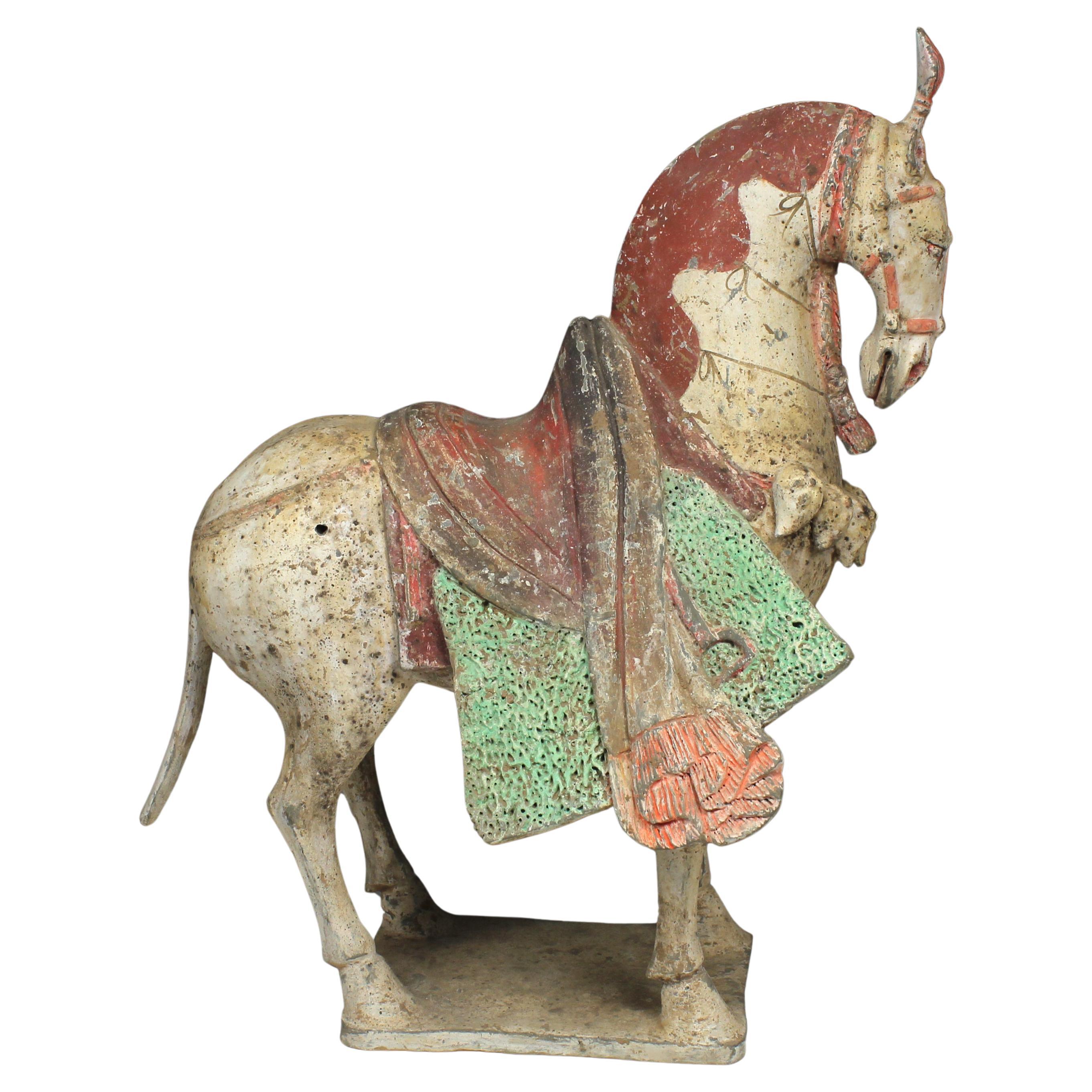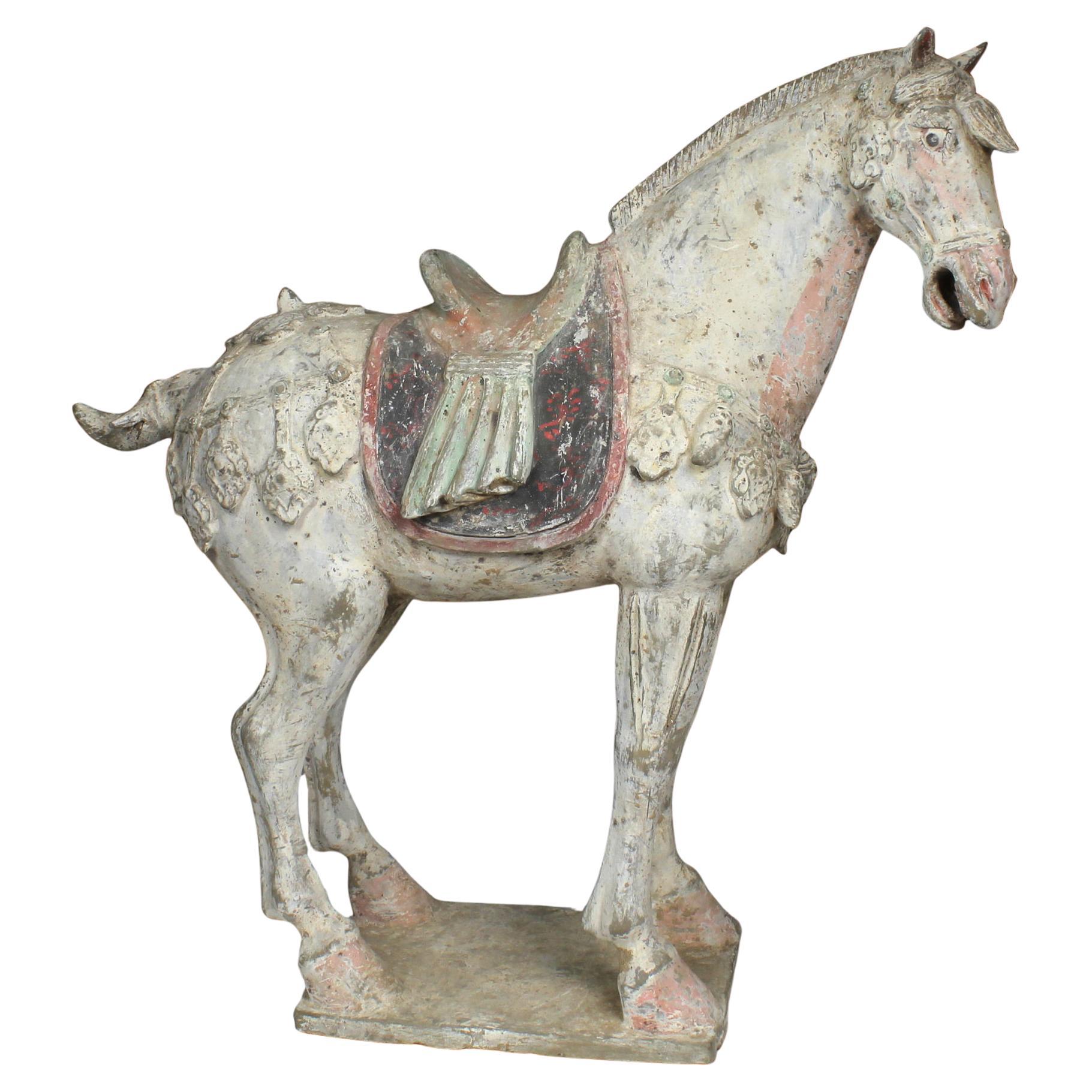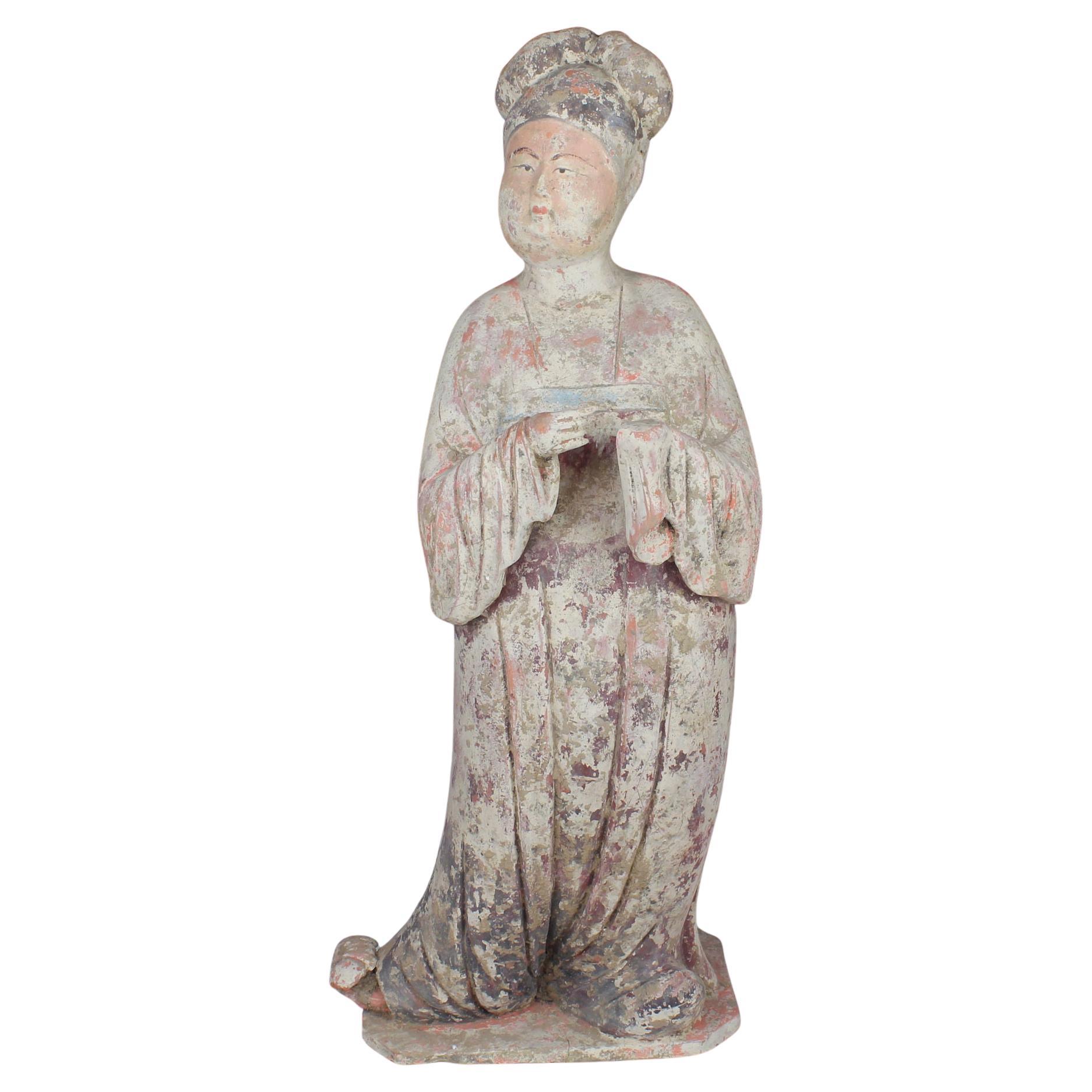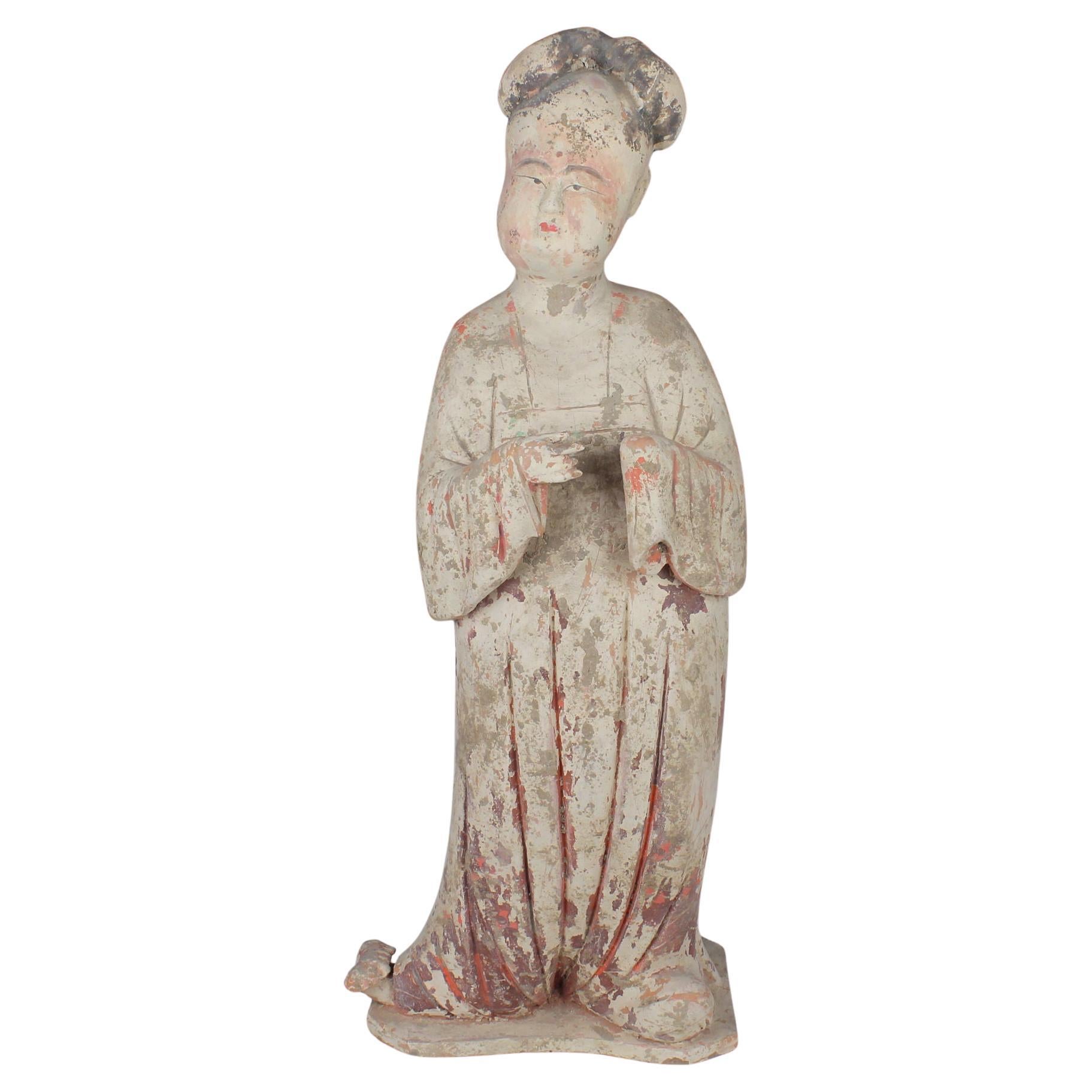Items Similar to Chinese statuette of a Sogdian rider
Want more images or videos?
Request additional images or videos from the seller
1 of 13
Chinese statuette of a Sogdian rider
About the Item
ITEM: Statuette of a Sogdian rider
MATERIAL: Pottery
CULTURE: Chinese, Tang Dynasty
PERIOD: 618 – 907 A.D
DIMENSIONS: 560 mm x 510 mm x 175 mm
CONDITION: Good condition. Includes Thermoluminescence test by Laboratory Kotalla (Reference 26PR180521)
PROVENANCE: Ex Belgian private collection (2022), Ex English art gallery, Ex English private collection, East Anglian, acquired from Hong Kong art market in 1990s
Comes with Certificate of Authenticity and Export Licence. If you are from outside the European Union, we will have to apply for the export licence again for your country, this takes 4 to 6 weeks.
Due to the fragility and size of this piece, it can only be shipped within the European Union, United Kingdom and neighbouring countries that can be transported by road by private courier (door to door).
The Tang Dynasty (618-907 AD) in China was a period of great cultural flourishing and international exchange. During this time, the Tang Empire extended its influence along the Silk Road, facilitating vibrant trade and cultural interactions with various regions, including Central Asia. The Sogdians, an ancient Iranian people, played a significant role in these exchanges as they were prominent traders along the Silk Road. Sogdian merchants established communities in Tang China, contributing to the cosmopolitan atmosphere of the dynasty. These interactions led to the assimilation of foreign elements into Tang culture, enriching it with diverse influences.
One remarkable aspect of Tang-Sogdian cultural exchange is reflected in the depiction of Sogdian riders in Minqi art. Minqi, or “folk art,” encompassed a wide range of popular art forms in Tang China, including pottery figurines. These figurines often depicted scenes of daily life, including various ethnic groups such as Sogdian riders. The representation of Sogdian riders in Minqi art not only reflects the presence of Sogdian communities in Tang China but also underscores the cultural integration and exchange occurring during this period.
The depiction of Sogdian riders in Tang Dynasty Minqi art provides valuable insights into the multicultural nature of Tang society and its vibrant cultural exchanges along the Silk Road. These figurines serve as tangible evidence of the dynamic interactions between different ethnic groups and the assimilation of foreign elements into Tang culture.
唐朝(公元618年至907年)是中国文化蓬勃发展和国际交流的一个时期。在这段时间里,唐帝国沿着丝绸之路扩展了其影响力,促进了与包括中亚在内的各个地区的繁荣贸易和文化交流。苏格底亚人,古代伊朗人,在这些交流中扮演了重要角色,因为他们是丝绸之路上杰出的商人。苏格底亚商人在唐代中国建立了社区,为这个朝代的国际化氛围做出了贡献。这些互动导致了外来元素的同化,丰富了唐代文化,赋予了它多元的影响。
唐苏格底亚文化交流的一个显著方面体现在民器艺术中对苏格底亚骑手的描绘。民器,即“民间艺术”,包括唐代中国各种流行艺术形式,包括陶瓷人物塑像。这些塑像经常描绘日常生活场景,包括各种族群,如苏格底亚骑手。苏格底亚骑手在民器艺术中的描绘不仅反映了苏格底亚社区在唐代中国的存在,还强调了这一时期发生的文化整合和交流。
唐代民器艺术中对苏格底亚骑手的描绘为我们提供了有关唐代社会多元文化特性以及沿丝绸之路的活跃文化交流的宝贵见解。这些塑像作为动态的不同族群之间互动和外来元素同化进入唐代文化的有形证据。此外,它们突显了丝绸之路作为文化交流的通道的重要性,在这里,思想、商品和人流自由流动,为唐代文明的丰富性和多样性做出了贡献。
- Dimensions:Height: 22.05 in (56 cm)Width: 20.08 in (51 cm)Depth: 6.89 in (17.5 cm)
- Style:Tang (Of the Period)
- Materials and Techniques:
- Place of Origin:
- Period:
- Date of Manufacture:Tang Dynasty, 618 – 907 A.D
- Condition:Wear consistent with age and use.
- Seller Location:EL CAMPELLO, ES
- Reference Number:1stDibs: LU7382239036322
About the Seller
5.0
Vetted Seller
These experienced sellers undergo a comprehensive evaluation by our team of in-house experts.
Established in 2011
1stDibs seller since 2022
8 sales on 1stDibs
- ShippingRetrieving quote...Ships From: El Campello, Spain
- Return PolicyA return for this item may be initiated within 60 days of delivery.
More From This SellerView All
- Chinese statuette of a horse with riderLocated in EL CAMPELLO, ESITEM: Statuette of a horse with rider MATERIAL: Pottery CULTURE: Chinese, Tang Dynasty PERIOD: 618 – 907 A.D DIMENSIONS: 520 mm x 420 mm x 180 mm CONDITION: Good condition. Includes ...Category
Antique 15th Century and Earlier Chinese Tang Antiquities
MaterialsPottery
- Chinese statuette of a horseLocated in EL CAMPELLO, ESITEM: Statuette of a horse MATERIAL: Pottery CULTURE: Chinese, Northern Wei Dynasty PERIOD: 386 – 535 A.D DIMENSIONS: 404 mm x 350 mm x 230 mm CONDITION: Good condition. Includes Th...Category
Antique 15th Century and Earlier Chinese Tang Antiquities
MaterialsPottery
- Chinese statuette of a horseLocated in EL CAMPELLO, ESITEM: Statuette of a horse MATERIAL: Pottery CULTURE: Chinese, Tang Dynasty PERIOD: 618 – 907 A.D DIMENSIONS: 560 mm x 530 mm x 200 mm CONDITION: Good condition. Includes Thermolumin...Category
Antique 15th Century and Earlier Chinese Tang Antiquities
MaterialsPottery
- Chinese statuette of a Fat LadyLocated in EL CAMPELLO, ESITEM: Statuette of a Fat Lady MATERIAL: Pottery CULTURE: Chinese, Tang Dynasty PERIOD: 618 – 907 A.D DIMENSIONS: 655 mm x 265 mm x 210 mm CONDITION: Good condition. Includes Thermoluminescence test by Laboratory Kotalla (Reference 05B101123). Includes Certificate of Authenticity from Dutch gallery PROVENANCE: Ex Belgian private collection, acquired from Dutch art gallery Comes with Certificate of Authenticity and Export Licence. If you are from outside the European Union, we will have to apply for the export licence again for your country, this takes 4 to 6 weeks. Due to the fragility and size of this piece, it can only be shipped within the European Union, United Kingdom and neighbouring countries that can be transported by road by private courier (door to door). This beautifully-finished ceramic attendant was made during what many consider to be China’s Golden Age, the Tang Dynasty. It was at this point that China’s outstanding technological and aesthetic achievements opened to external influences, resulting in the introduction of numerous new forms of self-expression, coupled with internal innovation and considerable social freedom. The Tang dynasty also saw the birth of the printed novel, significant musical and theatrical heritage and many of China’s best- known painters and artists. The Tang Dynasty was created on the 18th of June, 618 AD, when the Li family seized power from the last crumbling remnants of the preceding Sui Dynasty. This political and regal regime was long-lived, and lasted for almost 300 years. The imperial aspirations of the preceding periods and early Tang leaders led to unprecedented wealth, resulting in considerable socioeconomic stability, the development of trade networks and vast urbanisation for China’s exploding population (estimated at around 50 million people in the 8th century AD). The Tang rulers took cues from earlier periods, maintaining many of their administrative structures and systems intact. Even when dynastic and governmental institutions withdrew from management of the empire towards the end of the period – their authority undermined by localised rebellions and regional governors known as jiedushi –the systems were so well- established that they continued to operate regardless. The artworks created during this era are among China’s greatest cultural achievements. It was the greatest age for Chinese poetry and painting, and sculpture also developed (although there was a notable decline in Buddhist sculptures following repression of the faith by pro-Taoism administrations later in the regime). It is disarming to note that the eventual decline of imperial power, followed by the official end of the dynasty on the 4th of June 907, hardly affected the great artistic turnover. During the Tang Dynasty, restrictions were placed on the number of objects that could be included in tombs, an amount determined by an individual’s social rank. In spite of the limitations, a striking variety of tomb furnishings – known as mingqi – have been excavated. Entire retinues of ceramic figures – representing warriors, animals, entertainers, musicians, guardians and every other necessary category of assistant – were buried with the dead in order to provide for the afterlife. Warriors (lokapala) were put in place to defend the dead, while horses/ camels were provided for transport, and officials to run his estate in the hereafter. Of all the various types of mingqi, however, there are none more elegant or charming than the sculptures of sophisticated female courtiers, known – rather unfairly – as “fat ladies...Category
Antique 15th Century and Earlier Chinese Tang Antiquities
MaterialsPottery
- Chinese statuette of a Fat LadyLocated in EL CAMPELLO, ESITEM: Statuette of a Fat Lady MATERIAL: Pottery CULTURE: Chinese, Tang Dynasty PERIOD: 618 – 907 A.D DIMENSIONS: 645 mm x 260 mm x 180 mm CONDITION: Good condition. Includes Thermoluminescence test by Laboratory Kotalla (Reference 04B101123). Includes Certificate of Authenticity from Dutch gallery PROVENANCE: Ex Belgian private collection, acquired from Dutch art gallery Comes with Certificate of Authenticity and Export Licence. If you are from outside the European Union, we will have to apply for the export licence again for your country, this takes 4 to 6 weeks. Due to the fragility and size of this piece, it can only be shipped within the European Union, United Kingdom and neighbouring countries that can be transported by road by private courier (door to door). This beautifully-finished ceramic attendant was made during what many consider to be China’s Golden Age, the Tang Dynasty. It was at this point that China’s outstanding technological and aesthetic achievements opened to external influences, resulting in the introduction of numerous new forms of self-expression, coupled with internal innovation and considerable social freedom. The Tang dynasty also saw the birth of the printed novel, significant musical and theatrical heritage and many of China’s best- known painters and artists. The Tang Dynasty was created on the 18th of June, 618 AD, when the Li family seized power from the last crumbling remnants of the preceding Sui Dynasty. This political and regal regime was long-lived, and lasted for almost 300 years. The imperial aspirations of the preceding periods and early Tang leaders led to unprecedented wealth, resulting in considerable socioeconomic stability, the development of trade networks and vast urbanisation for China’s exploding population (estimated at around 50 million people in the 8th century AD). The Tang rulers took cues from earlier periods, maintaining many of their administrative structures and systems intact. Even when dynastic and governmental institutions withdrew from management of the empire towards the end of the period – their authority undermined by localised rebellions and regional governors known as jiedushi –the systems were so well- established that they continued to operate regardless. The artworks created during this era are among China’s greatest cultural achievements. It was the greatest age for Chinese poetry and painting, and sculpture also developed (although there was a notable decline in Buddhist sculptures following repression of the faith by pro-Taoism administrations later in the regime). It is disarming to note that the eventual decline of imperial power, followed by the official end of the dynasty on the 4th of June 907, hardly affected the great artistic turnover. During the Tang Dynasty, restrictions were placed on the number of objects that could be included in tombs, an amount determined by an individual’s social rank. In spite of the limitations, a striking variety of tomb furnishings – known as mingqi – have been excavated. Entire retinues of ceramic figures – representing warriors, animals, entertainers, musicians, guardians and every other necessary category of assistant – were buried with the dead in order to provide for the afterlife. Warriors (lokapala) were put in place to defend the dead, while horses/ camels were provided for transport, and officials to run his estate in the hereafter. Of all the various types of mingqi, however, there are none more elegant or charming than the sculptures of sophisticated female courtiers, known – rather unfairly – as “fat ladies...Category
Antique 15th Century and Earlier Chinese Tang Antiquities
MaterialsPottery
- Chinese statuette of a horse with musicianLocated in EL CAMPELLO, ESITEM: Statuette of a horse with musician MATERIAL: Pottery CULTURE: Chinese, Tang Dynasty PERIOD: 618 – 907 A.D DIMENSIONS: 420 mm x 365 mm x 145 mm CONDITION: Good condition. Includ...Category
Antique 15th Century and Earlier Chinese Tang Antiquities
MaterialsPottery
You May Also Like
- Chinese Tang Dynasty Sancai Glazed Horse and Rider, TL Tested, ChinaLocated in Austin, TXA fine and unusual Chinese Tang Sancai glazed model of a horse and rider, Tang Dynasty (618 to 906 CE), early 8th century, China. This fantastic sculpture portrays a male figures se...Category
Antique 15th Century and Earlier Chinese Tang Antiquities
MaterialsEarthenware, Pottery
- Pair of Chinese Painted Pottery Han Dynasty Horse and RidersLocated in Austin, TXA pair of Han Dynasty (206 BC-220 AD) painted pottery horse and riders, China. The horses modeled standing foursquare, supporting their eque...Category
Antique 15th Century and Earlier Chinese Han Sculptures and Carvings
MaterialsPottery
- Antique Chinese Opium Box in Hammered Brass, Decorated with a Scene of a RiderLocated in Leuven , BEThe cylindrical opium container is executed in hammered brass and decorated with an expressive repose design of a rider in a landscape with blossom tre...Category
20th Century Chinese Antiquities
MaterialsBrass
- Tang Dynasty Painted Pottery Horse and Rider, TL TestedLocated in Austin, TXA charming Tang dynasty painted pottery figure of a horse and mounted noble rider. TL tested by Oxford Authentication. The horse portrayed standing fours...Category
Antique 15th Century and Earlier Chinese Tang Antiquities
MaterialsEarthenware
- Chinese Tang Dynasty Painted Pottery Model of a CamelLocated in Austin, TXA powerfully sculpted Chinese Tang Dynasty pottery model of a camel. The camel is portrayed in a walking stance, long neck extended, with head held high, mouth askew chewing cud. The...Category
Antique 15th Century and Earlier Chinese Tang Antiquities
MaterialsPottery
- China 618-907 AD Tang Dynasty Pair Of Polychromate Earth Spirits ZhenmushouLocated in Miami, FLPair of Earths Spirits "Zhenmushou" from the China Tang Dynasty 618-907 AD. A beautiful and rare pair of "Earths Spirits guardians" from the Yunnan province region in the ancient China. This was created in clay earthenware pottery during the Tang Dynasty period between 618 and 907 AD. Featuring the molded figures of two seated guardians with decorations with polychrome pigmentations. The figures are seated on their haunches with cloven hooves planted firmly on the base looking forward with their front legs in a straight position. Both with face and body alert expressions on a rectangular base. Earth spirits usually appear in pairs, one with a human head and the other with a lion head. Their supernatural powers, indicated by antlers, spiky flanges and flames, enable them to confront evil spirits and protect any precincts within their gaze. Have been believed to protect the living by keeping the spirits of the dead from inappropriately roaming the world outside the tomb. Zhenmushou or guardian deities, developed from a line of protective spirits found normally in pairs at the front of Tang dynasty tombs. They served both to protect the figure from untoward spirits, and the outside world from the roving spirit of the dead. Combining features from a number of animals to form the perfect mythic beast, these mythical creatures were perceived to be the ideal guardians of the dead The semi human faced figure has a measures of 11.25 by 4.5 by 5.75 inches (28.57 x 11.43 x 14.60 Cm). The mythological lion animal figure has a measures of 10 by 5 by 5.8 inches (24.5 x 12.7 x 14.73 Cm). Tang dynasty or Tang Empire, was an imperial dynasty of China that ruled from 618 to 907, with an interregnum between 690 and 705. It was preceded by the Sui dynasty and followed by the Five Dynasties and Tend Kingdoms period. Historians generally regard the Tang as a high point in Chinese civilization, and a the golden age of cosmopolitan culture. Tang territory, acquired through the military campaigns of its early rulers, rivaled that of the Han dynasty. The Li family founded the dynasty, seizing power during the decline and collapse of the Sui Empire and inaugurating a period of progress and stability in the first half of the dynasty's rule. The dynasty was formally interrupted during 690–705 when Empress Wu Zetian seized the throne, proclaiming the Wu Zhou dynasty...Category
Antique 15th Century and Earlier Chinese Tang Antiquities
MaterialsEarthenware, Pottery
Recently Viewed
View AllMore Ways To Browse
Antique Hong
Dog Pottery Dynasty
Midcentury Modern Coffee Table And Side Tables
Vintage Modern Upholstered Chairs
Italian Chrome And Glass Tables
Italian Glass And Chrome Tables
Embassy Silver
Hand Painted Black Table
New Danish Dining Chairs
13 Vase
Built Ins
Vintage Corner Piece
Wood Chair Danish 1960s
Set Of Two Lights
Glass And Brass Vintage Pendant Light
Box On Feet
Vintage Table Set With Chairs
Patterned Top Side Table





